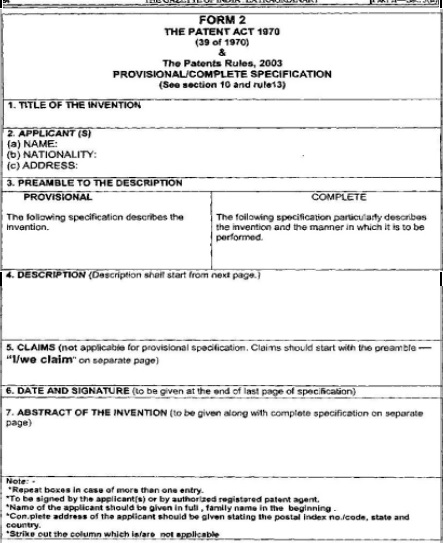In this article, Deepshikha Sarkar discusses how to file a Provision Patent application in India.
What is a Provisional Patent Specification?
According to Section 9 of Indian Patent Act 1970, there exist two types of patent specifications,
- Provisional Patent Specifications
- Complete Patent Specifications (Non-Provisional according to USPTO)
A provisional patent specification is a preliminary application before filing a usual patent. It explains the invention in a broad manner but not completely. It is the document which may be filed before a Complete Specification in the Office of the Controller of Patents pertaining to a prospective patent.
It gets the word “provisional” in its name from being incomplete and a predecessor of a complete specification which comes later. Also, although it is not mandatory, it is highly recommended as it has a lot of benefits for the inventor.
Why should an inventor file a Provisional Patent Specification?
Earlier Patent Filing Date
On filing of the Provisional Patent Specification the inventor is entitled to an earlier filing date. This is key as it secures the priority date for the applicant. The benefits of this are numerous
- The fact that similar inventions which are filed after the filing date of the provisional cannot become prior art for the applicants invention.
- If any dispute regarding the ownership of the invention arises, the Patent Office will accept the provisional patent’s earlier filing date as the date of filing.
Cost Effective
- The upfront cost of a Provisional Patent Specification is much lower than that of a complete patent application which saves thousands of rupees for the inventor in terms of professional fees.
- Also, as it is technically more lucid (does not contain claims, prior art search and exhaustive and detailed drawings) as compared to the Complete Specification it costs less money and resources to prepare. Provisional Patent Specification can also be prepared by the in inventor himself.
Buffer time period to further develop claims based on industry research
When an invention is new, you will not know what to claim protection for. There is a pendency period of twelve months between the provisional patent specification and complete patent specification. This may be used for
- Researching on the invention regarding its value in the market and commercial viability
- Improving its features and making it technically more sophisticated.
“Patent Pending” tag
Once the Provisional Patent Specification has been filed the inventor can legally use the tag “Patent Pending” or “Patent Applied” for his or her invention. This tag aids in obtaining funds as the credibility of the invention increases while the business model is being set up in the background. It can be used as a selling proposition.
Scope of Abandonment (economical)
If the Applicant goes for a provisional specification and then realises that it is not commercially viable or chooses not to get a patent, he might abandon it. But if in the same scenario if he had gone for a complete specification he would have already spent a lot of money on it and the abandonment would have been expensive.
Secrecy
As there no publication of the patent application, the priority date is reserved by maintaining the secrecy.
What should an inventor keep in mind while filing a Provisional Patent Specification?
An Applicant should remember the following things
- It is not a rough draft of the Complete Patent Specification. Whereas it defines the scope of the invention and it is the Provisional Patent Specification on which the following Complete Specification and finally the grant of Patent will be based upon.
All the elements of the invention which are born during the 12 months between the Provisional Patent Specification and Complete Patent Specification filing will not get the earlier priority date. Any addition/development to the invention after filing PROVISIONAL PATENT SPECIFICATION which is outside the scope which is set by provisional application will not have the advantage of priority date of provisional application.
- The inventor/applicant should keep in mind that this is not the ‘final’ or ‘conclusive’ step towards securing a patent. It is the initial step in the procedure towards patent registration.
- It has to be kept in mind that if the time period of twelve months within which the applicant has to file Complete Patent Specification is not adhered to then the patent application will be deemed to be ‘abandoned’.
- Although the confidentiality is maintained after the Provisional Patent Application, complete and adequate disclosures should be made in the Provisional Patent Application as incomplete applications will be disadvantageous for the applicant in the future and his scope of securing a patent may considerably reduce.
- A rough set of claims should be designed even though they need not be a part of the Provisional Patent Application. This should be done in order to conceptualize the invention and understand the implications of the invention completely.
What are the documents required to file a Provisional Patent Specification?
The following documents must be in proper order for a Provisional Patent Specification
- Form 1 ( Application for grant of patent), THE PATENTS ACT 1970 (39 of 1970) and THE PATENTS RULES, 2003.
- Form 2 (Provisional Specifications), THE PATENTS ACT 1970 (39 of 1970) and THE PATENTS RULES, 2003.
- Form 5 ( Declaration of Inventorship) THE PATENTS ACT 1970 (39 of 1970) and THE PATENTS RULES, 2003.
- Form 26 (Power of Attorney). THE PATENTS ACT 1970 (39 of 1970) and THE PATENTS RULES, 2003. If your patent is filed by a Patent Agent then this form is necessary, otherwise not.
- E-filing fees (Patent Statutory fee) THE PATENTS ACT 1970 (39 of 1970) and THE PATENTS RULES, 2003 (Electronic Payment).
- Form 3 (Corresponding foreign patent application statement and undertakings) THE PATENTS ACT 1970 (39 of 1970) and THE PATENTS RULES, 2003.
- Priority Document ( This is used for convention applications if priority date is claimed).
- Illustrations/Drawings of the invention.
What are the components of a Provisional Patent Specification?
The two broad divisions are Title and Description of the Patent.
TITLE
The Provisional Patent Specification should begin with the title of the invention. The title should fairly capture features of the invention and should be short and to the point. It should be under fifteen words. The inventors’ name, the word “Patent”, the abbreviation “etc.”, words in various languages or any fancy words should not be used in the title.
An illustration of patent TITLE is given below.
- “a steering mechanism incorporating an automatic feed-back circuit…”
- “an insecticide consisting X,Y,Z; or”
DESCRIPTION
The description begins with the Preamble and contains the field and object of invention. It begins on a fresh page after the Title. The Provisional Patent Specification does not need to have “claims”
PREAMBLE
The description of the invention in a Provisional Patent Specification starts with the Preamble ‘The following Specification describes the invention’.
FIELD
The technical field to which the invention belongs to should be mentioned in this section. It should be crisp to the point that it can be easily identified that what is the nature of the invention and classification of its technology. While mentioning the field it should be kept in mind that it does not ‘limit the scope’ the invention in any sense.
For example, the term “liquid dispensing machine” should be used in the place of “coffee dispensing machine” in which case it would limit the scope and eliminate dispensing soda, tea, etc.
OBJECT
The point of having this section is in showing the necessity of the invention. The advantages that the invention would bring about should be primarily solutions made by the invention.
The statements which can be used in this section include “the principle object of this invention is …”; “Another object of the invention is …”.
Important differences between a provisional and a complete application
- A Provisional specification may be filed even in the case where the idea of the invention is not completely mature. But in the case of a complete specification there remains no scope for further development as it requires filing of detailed claims.
- A provisional patent application is relatively inexpensive as compared to a complete application as the provisional specification doesn’t include all the parts of a patent application and doesn’t require the same amount of time as a complete and so as a result the professional fee charged is lesser although the statutory fees is the same.
- As opposed to a complete specification which needs to include all the parts of a patent application, a provisional specification need not include the claims and abstract.
- A complete specification is mandatory in order to secure a patent and can exist independently. A provisional patent application has no existence if a corresponding complete application is not filed within 12 months as the patent application is considered to be abandoned.
- Though, both the provisional and complete application can be used for claiming priority, however, any foreign application filing like PCT application or a convention application needs to be mandatorily accompanied by a complete specification only.
Is it advisable for inventors in India to file a Provisional Patent Specification?
Patent attorneys in the India are of the opinion that a Provisional Patent Specification may not be of high utility. However it does save money in terms of only professional fee of agent/lawyer involved but the statutory fees as per First Schedule under The Patents Rules, 2003 is the same case of both Provisional and Complete Patent Specifications.
Also, inventors may file a 1-2 page provisional patent application themselves, and comfortably assume that they will come back a year later and pay a patent attorney to write a complete patent application. Entrepreneurs often think that they are “protected”, so they go out and freely discuss their inventions with customers, investors, and the general public during the one-year period which does more harm than good. This is because there are high chances that a part of such discussions includes the developments made during the 12 month interim period and they do not have the earlier priority date hence, there lies no claim with the inventor if someone copies the idea.
 Serato DJ Crack 2025Serato DJ PRO Crack
Serato DJ Crack 2025Serato DJ PRO Crack










 Allow notifications
Allow notifications



Excellent information.
Very useful article.
thanks for this article